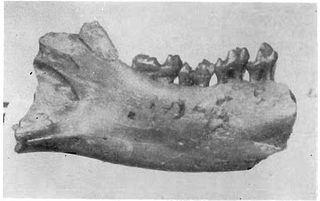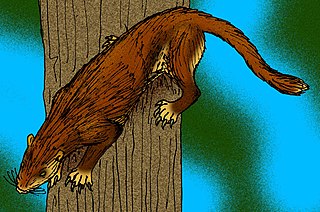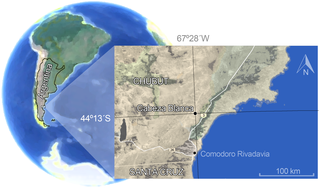Eobaatar is a genus of extinct mammal from the Lower Cretaceous of Mongolia, Spain and England. A member of the also extinct order Multituberculata, it lies within the suborder Plagiaulacida and family Eobaataridae. The genus Eobaatar was named by Kielan-Jaworowska Z., Dashzeveg D. and Trofimov B.A. in 1987. Its name was made from Greek "eos" = "dawn" and Mongolian "baatar" = "hero"", "warrior".

The family Aplodontiidae also known as Aplodontidae, Haplodontiidae or Haploodontini is traditionally classified as the sole extant family of the suborder Protrogomorpha. It may be the sister family of the Sciuridae. There are fossils from the Oligocene until Miocene in Asia, from Oligocene in Europe and from the Oligocene until the present in North America, where there is the only living species: the mountain beaver.

Hyaenodon ("hyena-tooth") is an extinct genus of carnivorous placental mammals from extinct tribe Hyaenodontini within extinct subfamily Hyaenodontinae, that lived in Eurasia and North America from the middle Eocene, throughout the Oligocene, to the early Miocene.

Cramauchenia is an extinct genus of litoptern South American ungulate. Cramauchenia was named by Florentino Ameghino. The name has no literal translation. Instead, it is an anagram of the name of a related genus Macrauchenia. This genus was initially discovered in the Sarmiento Formation in the Chubut Province, in Argentina, and later it was found in the Chichinales Formation in the Río Negro Province and the Cerro Bandera Formation in Neuquén, also in Argentina, in sediments assigned to the SALMA Colhuehuapian, as well as the Agua de la Piedra Formation in Mendoza, in sediments dated to the Deseadan. In 1981 Soria made C. insolita a junior synonym of C. normalis. A specimen of C. normalis was described in 2010 from Cabeza Blanca in the Sarmiento Formation, in sediments assigned to the Deseadan SALMA.
Eurymylidae is a family of extinct simplicidentates. Most authorities consider them to be basal to all modern rodents and may have been the ancestral stock whence the most recent common ancestor of all modern rodents arose. However, the more completely known eurymylids, including Eurymylus, Heomys, Matutinia, and Rhombomylus, appear to represent a monophyletic side branch not directly ancestral to rodents. Huang et al. (2004) have argued that Hanomys, Matutinia, and Rhombomylus form a clade characterized by distinctive features of the skull and dentition that should be recognized as a separate family, Rhombomylidae. Eurymylids are only known from Asia.

Altanius is a genus of extinct primates found in the early Eocene of Mongolia. Though its phylogenetic relationship is questionable, many have placed it as either a primitive omomyid or as a member of the sister group to both adapoids and omomyids. The genus is represented by one species, Altanius orlovi, estimated to weigh about 10–30 g (0.35–1.1 oz) from relatively well-known and complete dental and facial characteristics.

The Klerf Formation is an Early Devonian (Emsian) formation that includes a Lagerstätte in the Northern Eifel hills, at Willwerath near Prüm, Rhineland-Palatinate, Germany. In it Jaekelopterus rhenaniae, a giant eurypterid was discovered. The Klerf Formation, comprising greenish and reddish shales, siltstones and sandstones, was first described in 1919 by Rudolf Richter (1881-1957) and reaches a maximum thickness of about 1,300 metres (4,300 ft). It is part of Alken quarry along with Nellenköpfchen Formation.

Asiavorator is an extinct genus of civet-like carnivoran belonging in the family Stenoplesictidae. It was endemic to Asia and lived during the Eocene and Oligocene epochs.
The Irdin Manha Formation is a geological formation from the Eocene located in Inner Mongolia, China, a few kilometres south of the Mongolian border.

Hyopsodontidae is an extinct family of primitive mammals, initially assigned to the order Condylarthra, living from the Paleocene to the Eocene in North America and Eurasia. Condylarthra is now thought to be a wastebasket taxon; hyopsodontids have occasionally been speculated to be related to Afrotheria, but the most recent consensus is that they are related to Perissodactyla. Analysis of the inner ear shows shared characteristics with the Equoidea ; they may be a basal ungulate group near to perissodactyls.
This paleomammalogy list records new fossil mammal taxa that were described during the year 2012, as well as notes other significant paleomammalogy discoveries and events which occurred during that year.
This paleomammalogy list records new fossil mammal taxa that were described during the year 2013, as well as notes other significant paleomammalogy discoveries and events which occurred during that year.
This paleomammalogy list records new fossil mammal taxa that were described during the year 2014, as well as notes other significant paleomammalogy discoveries and events which occurred during that year.
This paleomammalogy list records new fossil mammal taxa that were described during the year 2011, as well as notes other significant paleomammalogy discoveries and events which occurred during that year.
This paleomammalogy list records new fossil mammal taxa that were described during the year 2010, as well as notes other significant paleomammalogy discoveries and events which occurred during that year.
This paleomammalogy list records new fossil mammal taxa that were described during the year 2017, as well as notes other significant paleomammalogy discoveries and events which occurred during that year.
This paleomammalogy list records new fossil mammal taxa that were described during the year 2016, as well as notes other significant paleomammalogy discoveries and events which occurred during that year.
Geranoididae is a clade of extinct birds from the early to late Eocene and possibly early Oligocene of North America and Europe. These were mid-sized, long-legged flightless birds. Recent research shows that these birds may actually be palaeognaths related to ostriches.
This paleomammalogy list records new fossil mammal taxa that were described during the year 2015, as well as notes other significant paleomammalogy discoveries and events which occurred during that year.

The Sarmiento Formation, in older literature described as the Casamayor Formation, is a geological formation in Chubut Province, Argentina, in central Patagonia, which spans around 30 million years from the mid-Eocene to the early Miocene. It predominantly consists of pyroclastic deposits, which were deposited in a semi-arid environment. It is divided up into a number of members. The diverse fauna of the Sarmiento Formation, including a variety of birds, crocodilians, turtles and snakes, also includes many mammals such as South American native ungulates as well as armadillos, and caviomorph rodents.







